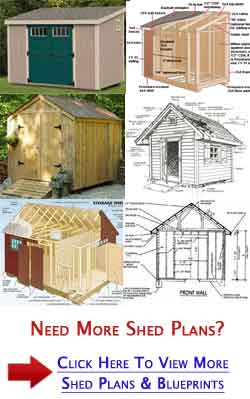

 buildyoursheddiy.com
buildyoursheddiy.com Introduction: Building Your Own Customizable DIY Shed Are you dreaming of extra storage, a workshop, or a backyard haven? Building your own shed is a fantastic way to customize a structure precisely to your needs and save money in the process. This step-by-step guide will walk you through the process of creating a customizable DIY shed, allowing you to adapt the design to your specific space and requirements.
Step 1: Planning and Design Before you even think about picking up a hammer, meticulous planning is crucial. This involves determining the shed's size, style, and purpose. Here's what to consider: Purpose: What will you primarily use the shed for? Storage, workshop, garden shed, or something else? This will heavily influence the size and layout. Size: Measure your available space and local building codes. Check for setback requirements and permit regulations. Draw a sketch of the shed's footprint on your property. Style: Choose a style that complements your home and yard. Common options include gable, gambrel, and lean-to sheds. Consider the roof pitch and overall aesthetic. Materials: Decide on your primary building materials. Wood framing is common and relatively affordable. Consider siding options like plywood, vinyl siding, or shiplap. For roofing, asphalt shingles are a popular choice. Foundation: Determine the type of foundation you'll use. Options include a gravel pad, concrete slab, or pressure-treated wood frame. The foundation must be level and provide adequate support. Blueprints: Create detailed blueprints or use pre-made shed plans. Accurate plans are essential for a successful build. They will specify the dimensions, materials list, and construction details.
Step 2: Gathering Materials and Tools Once you have your plans finalized, it's time to gather all the necessary materials and tools. A comprehensive list will prevent unnecessary trips to the hardware store. Lumber: Purchase lumber according to your plans, including framing lumber (2x4s, 2x6s), sheathing (plywood or OSB), and trim. Roofing: Obtain roofing materials like asphalt shingles, roofing felt, drip edge, and nails. Siding: Acquire siding materials based on your chosen style (plywood, vinyl siding, etc.) and fasteners. Fasteners: Stock up on nails, screws, and construction adhesive. Choose the correct size and type for each application. Doors and Windows: Purchase a pre-hung door and any windows you plan to install. Foundation Materials: Gather materials for your chosen foundation, such as gravel, concrete, or pressure-treated lumber. Tools: Ensure you have the following tools: circular saw, miter saw (optional but recommended), drill/driver, level, measuring tape, hammer, square, safety glasses, work gloves, ladder, and a sawzall (optional).
Step 3: Building the Foundation The foundation is the most critical part of the shed. A solid, level foundation ensures the shed's stability and longevity. Gravel Pad: For a gravel pad, excavate the area according to your plans. Add a layer of landscape fabric to prevent weed growth. Pour and compact several layers of gravel, ensuring a level surface. Concrete Slab: For a concrete slab, build a form from lumber. Pour concrete into the form, level it, and let it cure according to the manufacturer's instructions. Wood Frame: For a wood frame foundation, construct a rectangular frame using pressure-treated lumber. Ensure the frame is level and square. You may need to dig down to create a level base and add gravel underneath.
Step 4: Framing the Walls Framing the walls involves constructing the wall structures using lumber and fasteners. Cut the Lumber: Cut all the lumber for the wall frames according to your plans. Assemble the Frames: Assemble the wall frames on a flat surface. Use nails or screws to connect the studs to the top and bottom plates. Maintain consistent spacing between the studs (typically 16 or 24 inches on center). Install Door and Window Headers: Frame the openings for the door and windows using headers. The header size will depend on the width of the opening and the load it needs to support. Raise the Walls: Carefully raise the framed walls and secure them to the foundation. Use temporary bracing to keep the walls plumb and stable. Connect the Walls: Connect the walls to each other at the corners using nails or screws. Ensure the corners are square.
Step 5: Building the Roof Building the roof involves constructing the roof trusses or rafters and installing the sheathing. Truss Method: If using trusses, purchase pre-fabricated trusses or build your own according to your plans. Set the trusses in place and secure them to the top plates of the walls. Rafter Method: If using rafters, cut the rafters according to your plans and install them, connecting them to the ridge board and the top plates of the walls. Install Sheathing: Cover the roof frame with sheathing (plywood or OSB). Secure the sheathing to the trusses or rafters using nails or screws.
Step 6: Installing Siding and Roofing With the frame complete, it's time to enclose the shed with siding and roofing. Install Siding: Install the siding according to the manufacturer's instructions. Overlap the siding appropriately and secure it with nails or screws. Install Roofing Felt: Cover the roof sheathing with roofing felt to provide a waterproof barrier. Overlap the felt appropriately and secure it with roofing nails. Install Roofing: Install the roofing material (asphalt shingles, metal roofing, etc.) according to the manufacturer's instructions. Start at the bottom edge of the roof and work your way up, overlapping the courses properly. Add Drip Edge: Install drip edge along the eaves and rakes to prevent water from getting behind the siding and roofing.
Step 7: Installing Doors and Windows Installing doors and windows adds functionality and security to the shed. Install the Door: Install the pre-hung door in the framed opening. Ensure the door is plumb and swings freely. Install the door hardware (handle, lock). Install Windows: Install the windows in the framed openings. Seal around the windows with caulk to prevent drafts and water leaks.
Step 8: Finishing Touches The final step involves adding the finishing touches to complete the shed. Install Trim: Install trim around the doors, windows, and corners to give the shed a finished look. Paint or Stain: Paint or stain the shed to protect the wood and enhance its appearance. Add Shelving or Storage: Customize the interior of the shed with shelving, workbenches, or other storage solutions. Landscaping: Consider adding landscaping around the shed to blend it into the surrounding environment.
Conclusion: Your Customized Shed Awaits! Congratulations! You've successfully built your own customizable DIY shed. With careful planning, attention to detail, and a little elbow grease, you now have a functional and aesthetically pleasing structure that perfectly meets your needs. Enjoy your new space!
How To Build A Shed In Winter?
 buildyoursheddiy.com
buildyoursheddiy.com Easy To Follow Playhouse Shed Plans
 buildyoursheddiy.com
buildyoursheddiy.com Shed Plans With Loft Design Inspiration
 buildyoursheddiy.com
buildyoursheddiy.com


0 komentar:
Posting Komentar